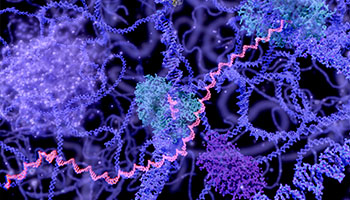HOW CAN WE HELP YOU? Call 1-800-TRY-CHOP
In This Section
How Does the Overexpression of MN1 Cause Acute Myeloid Leukemia?

Kathrin Bernt, MD, and her research team discover how MN1 causes AML.
The Findings
Meningioma-1 (MN1) is an oncogene that is rearranged and overexpressed in a subset of acute myeloid leukemia (AML), the second most common blood cancer in children. Over 70 percent of AML patients with high overexpression of MN1 die within two years, yet the mechanism by which MN1 causes this disease has largely remained a mystery — until now.
Researchers at Children’s Hospital of Philadelphia and the Perelman School of Medicine at the University of Pennsylvania found a novel mechanistic link between MN1 and the BAF complex, a site crucial for the regulation of gene expression and differentiation that is mutated in about 20 percent of cancers.
The researchers also found that the ability of MN1 to stabilize the BAF complex is dependent on a part of the MN1 protein structure known as the polyQ-stretch. Like protein “glue,” polyQ-stretches are best known for their role in neurodegenerative diseases like Huntington’s disease, wherein the elongation of the polyQ-stretch causes proteins to clump together, leading to neuronal death and neurodegeneration. The researchers found that deleting the polyQ-stretch impairs MN1’s ability to over-stabilize the BAF complex binding to DNA, thus allowing blood cells to differentiate normally.
Why It Matters
BAF is critical in reading DNA, interacting with regulatory regions that govern how much of a gene is expressed. The researchers discovered that overexpression of MN1 strengthens the BAF complex’s interaction with DNA, which has direct consequences for blood cell production. Bone marrow regularly produces progenitor and hematopoietic stem cells that eventually become mature blood cells. For that to happen, the cells need to turn off early programs that direct them to proliferate — and turn on programs that tell them what kind of cell to be. To shut down those early programs, promoters and regulatory regions need to be silenced, but when MN1 is overexpressed, it keeps reinforcing the interaction between BAF and DNA, which encourages the overproduction in the bone marrow of unwanted progenitor cells.
Who Conducted the Study
Kathrin Bernt, MD, a physician-scientist in CHOP’s Cancer Center’s Leukemia and Lymphoma Program was senior author, and Simone Riedel, PhD, a research postdoc fellow with the Division of Oncology, was first author. They were joined by numerous CHOP colleagues and University of Penn collaborators.
How They Did It
To better understand how MN1 overexpression causes AML, researchers worked with murine models to figure out what proteins MN1 interacts with, which helped them uncover the chain of events that ultimately leads to uncontrolled cell growth. Using a proteomics approach, the researchers identified the BAF complex as the main interaction partner of oncogenic MN1.
Quick Thoughts
“What’s exciting about this research is its potentially broad implications,” Dr. Bernt said. “This is a look at how cancer can happen beyond the classic mechanisms of overactive signaling and DNA damage.”
Where the Study was Published
The study appears in Molecular Cell.
What’s Next?
Studies building on these results, and supported by grants from Cookies for Kids Cancer and the Children’s Cancer Research Fund, aim to turn this discovery into a therapy.
Want to Learn More?
Check out CHOP News.


